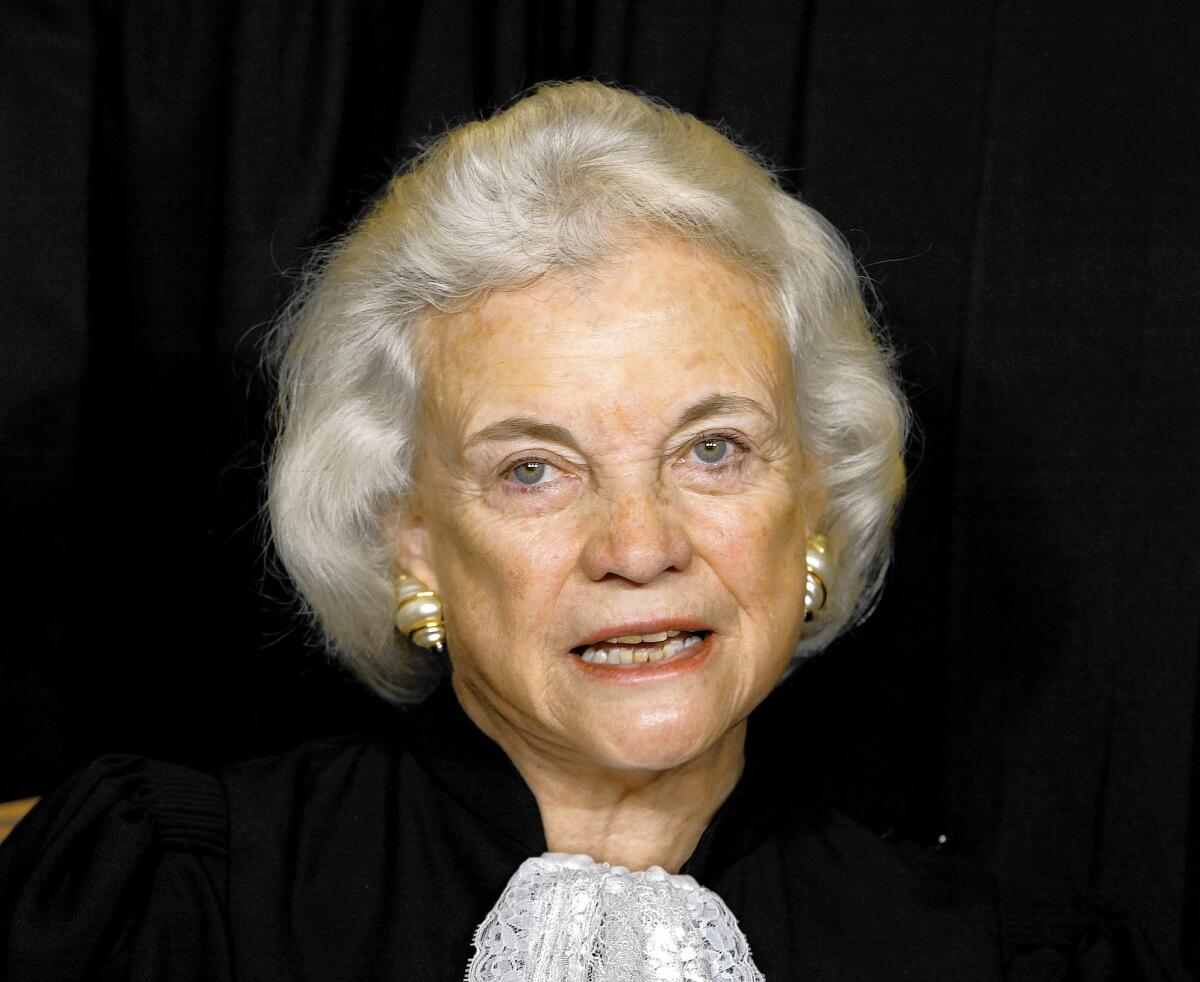Op-Ed: Sandra Day O’Connor and the fate of abortion rights

Supreme Court Associate Justice Sandra Day O’Connor poses during a group portrait session with the members of the U.S. Supreme Court, at the Supreme Court Building in Washington, Friday, Dec. 05, 2003.
- Share via
On Wednesday, the Supreme Court will hear oral arguments in Whole Women’s Health vs. Hellerstedt, a case that could reinforce or all but overturn the right to abortion. What’s at issue is a Texas law that requires abortion providers to have admitting privileges at a local hospital and to build expensive surgical facilities. Most analysts believe the law will end almost all abortion services in Texas – in fact, before the Supreme Court issued a stay, half the abortion clinics in Texas had closed because of it. Now the court must decide if the Texas regulations present an “undue burden” on a woman’s right to choose.
When the Supreme Court decided to review the case last year, all eyes turned to Justice Anthony Kennedy, the “swing vote” who might finally find a restriction he thought was too burdensome on women’s abortion rights. Even after the death of Antonin Scalia, Kennedy’s vote remains crucial: A 5-3 decision striking down the Texas law would protect abortion nationwide, but a 4-4 tie would leave the law in place until further Supreme Court review. The nation would look be left looking a lot like it did before Roe v. Wade: Some women, in some states, have ready access to abortion, but others do not.
How has it come to this? How is it that Roe vs. Wade can be essentially repealed, without the court addressing it directly? The trail leads to now-retired Justice Sandra Day O’Connor, who set a standard that both undermined Roe and helped to preserve it.
From her earliest days on the court, O’Connor waged a battle not against the right to abortion per se but the breadth of that right as it was established in Roe. Justice Harry Blackmun’s majority opinion said abortion could not be restricted during the first trimester of pregnancy, and after that, regulations were legal only to protect women’s health until the fetus was viable. Thereafter, the state could regulate — which is to say, limit — abortion, unless the limitation endangered a woman’s life or health.
O’Connor’s first vote on the issue came quickly after she was appointed to the high court in 1981. She disagreed with the majority’s overturning of an Akron, Ohio, ordinance regulating abortions — with a waiting period, limits on where abortions could be performed, and more. Her dissent says it all: Blackmun’s trimester-based approach to setting abortion rules is completely wrong. Instead, from the moment of conception, the government can do anything to restrain the pregnant woman as long as the restraint falls short of an undefined, wooly and uncertain “undue burden.”
The wishy-washy, wooly and uncertain language of “undue burden” was not the creation of the sensible, centrist O’Connor. She borrowed it from an aggressively anti-abortion brief submitted in the case by the Reagan Justice Department. It had, with little notice, successfully been used by court conservatives to justify the denial of Medicaid benefits for medically necessary abortions in 1980. (Not an undue burden, the thinking went, because all a woman had to do was — perhaps magically — get the money to pay for the abortion elsewhere.)
O’Connor waged a battle not against the right to abortion but the breadth of that right as it was established in Roe.
By 1989, when the next major abortion case came up, the court’s pro-choice majority was long gone. Asserting her undue burden standard, O’Connor withheld her vote from the four conservative justices who wanted to do away with Roe vs. Wade, but she was willing to approve all the obstacles to terminating a pregnancy the state of Missouri was defending, many of them similar to the Akron regulations that had been overturned seven years earlier.
By 1992, it looked like the court had five justices that would overrule Roe, regardless of O’Connor’s reservations, and send the matter back to the states. This was the moment her “undue burden” language formally rescued national abortion rights. In Planned Parenthood vs. Casey yet another set of restrictions was tested, this time in Pennsylvania. By crafting a decision that replaced Roe’s almost unlimited right with her more restrictive standard, she gets a lot of the credit for securing a majority (including Kennedy) willing to leave intact at least the theoretical right to an abortion. Roe survived, but so did Pennsylvania’s regulations.
O’Connor’s inquiry into what burden is or is not undue open-ended language made her the designated abortion decider on the court until she retired in 2006. In 2003, for example, Nebraska decided it wouldn’t be a burden if women were denied a type of late abortion. O’Connor disagreed, and the Nebraska law was struck down 5-4. Congress later passed a law like Nebraska’s; when it. came before the court, O’Connor was gone and Kennedy wrote the majority opinion. He agreed to outlaw “partial birth abortion.” (He also added his personal opinion that women must feel bad about their abortions, even if they didn’t say it to anyone who polled them.)
The undue burden standard in the hands of a reasonably well-intentioned justice, like O’Connor, is not automatically disastrous for Roe. But when O’Connor left the court, her ability to persuade others, to assert the balance implied by undue burden, went with her.
Now 24 states have enacted TRAP laws -- targeted regulation of abortion providers. The Texas’ law before the court this week fits this description. Its legislature asserts that it believes protecting women’s health requires that abortion take place in free standing surgical units with ties to local full service hospitals. The American Medical Assoc. and the American College of Obstetricians and Gynecologists disagrees but, Texas argues, fact-finding is usually left to the legislature. O’Connor’s standard is so elastic it is vulnerable to such moves, and they have been effective.
O’Connor has said publicly she thinks President Obama should get to appoint Scalia’s successor. If that were to happen, attacks on abortion rights would be defeated by a liberal Supreme Court and the nation would be bound by the decision. But in her response to the court vacancy, O’Connor is likely to prove better than her republic. It is ironic that her calibrated actions — the attempt to balance abortion rights and limits —- have come perilously close to achieving exactly what she strived to avoid in 1992: Throwing abortion back to the states, where it can rend the nation apart.
Linda Hirshman is the author of “Sisters in Law: How Sandra Day O’Connor and Ruth Bader Ginsburg Went to the Supreme Court and Changed the World.”
Follow the Opinion section on Twitter @latimesopinion and Facebook
More to Read
A cure for the common opinion
Get thought-provoking perspectives with our weekly newsletter.
You may occasionally receive promotional content from the Los Angeles Times.









